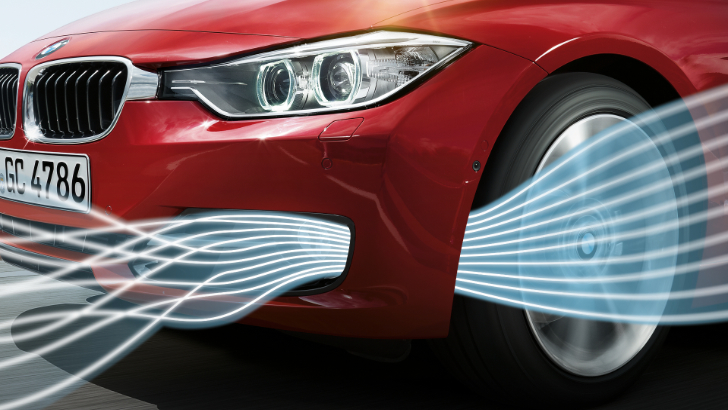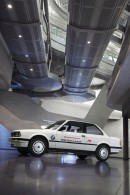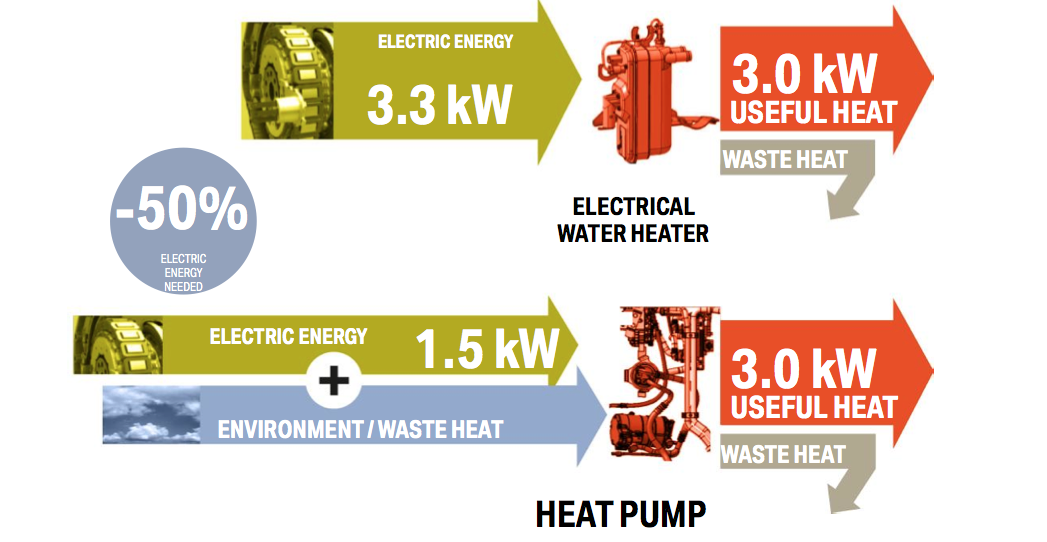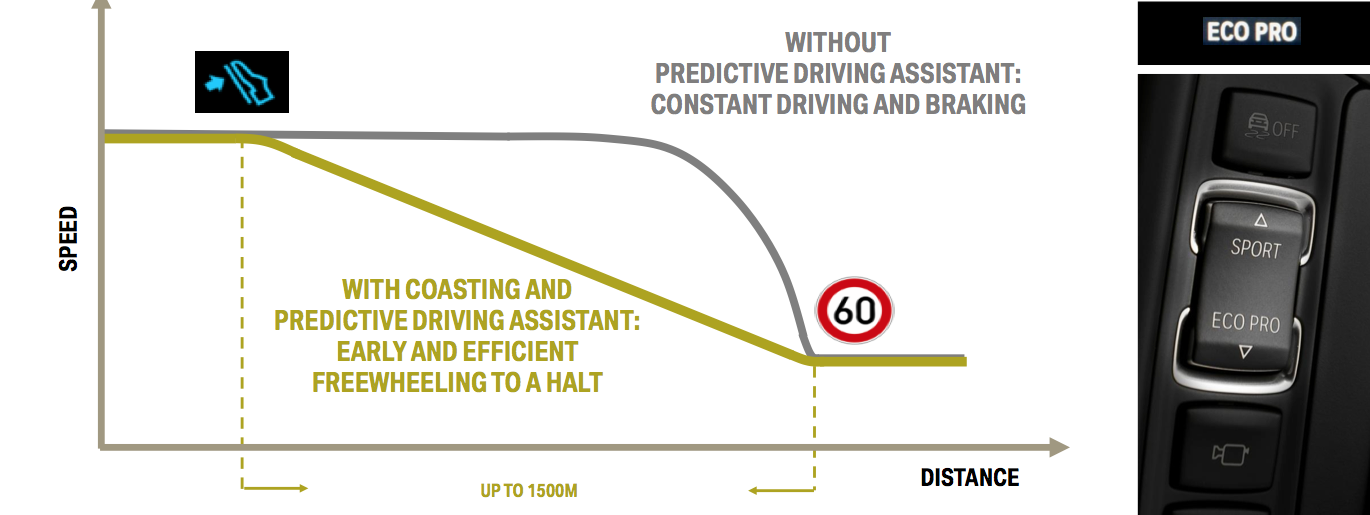← Continued from Page 1 of "An In-Depth Look at How BMW's EfficientDynamics Works"Developing a car like the i3 from the ground up will pose some challenges though and these challenges will prove useful in the future development of cars. For example, replacing an internal combustion engine with an electric one means you can't rely on the engine's heat anymore to make yourself comfortable inside the car during winters.
Heating has become a problem that needed to be solved, of course while keeping energy consumption in check and abiding by what EfficientDynamics stands for. In this regard, BMW introduced the heat pump.
This device uses the difference in temperature to create heat and pumps it into the cabin. This way, the energy consumption is reduced by 50% compared to a classical heating system that uses resistors. But there are even better solutions.
EfficientDynamics looks at the problem from a holistic point of view. So, it's winter and you need to keep yourself warm while driving the car. The things is though, that most of the time people are alone in their cars. Therefore a question was raised: why heat the whole cabin when there's only 1 person inside it?
Heat would only be needed in the driver's seat so that's the only place where you'd actually need to feel warm. But even with the four-zone climate control you can't project heat into one specific area so precisely. They had to go beyond conventional solution and came up with infrared heating surfaces.
How does it work? Energy is transferred as infrared radiation that heats the passenger's bodies directly. The advantages of such a system are numerous and important. First of all, you get instant heating to a target area without loss along the way (it takes about a minute to heat up), it's noiseless, draught-free, has a higher efficiency for EVs and plug-in hybrids through effective energy transmission and is seat selective, therefore reducing the consumption.
In an era of GPS positioning and Google Maps, navigation systems had to be used to reduce fuel efficiency even more. That was the next step in creating the ultimate fuel saving machine.
Predictive Drivetrain Management is a feature that will be more and more popular on BMW model in the future. At the moment only the F15 X5 and 5 Series LCI models are using it, but prospects are looking good. What does it mean?
The navigation system uses the maps and predefined course you enter into your car's infotainment system to predict the road ahead and adjust your car's speed correspondingly so that you consume the least amount of fuel as possible. If the car knows that there's a hill coming up after a curve to the right and the speed limit on top of that hill is 60 mph, it will automatically shift gears so that your car reaches the top of the hill with a maximum speed of 60 mph with the least amount of fuel possible.
All of these sound like Sci-Fi articles but they are actually being used as we speak without drivers even knowing it. That's because the engineers made sure that the system will adapt to your driving style. If you like to break the law and drive with an average speed of 100 mph, the system won't interfere. If you're a careful driver that obeys the law and you're not in a hurry to get anywhere, it will help you out without you even noticing.
Another feature that uses the navigation system to reduce fuel consumption is the ECO PRO driving style. When engaged, this feature will automatically calculate the best route for maximum fuel saving. It will also let you know when to decelerate when driving down the road so that you can anticipate the traffic in the best way possible, by flashing a sign on your iDrive screen.
On top of that, in ECO PRO mode, at speeds between 50 km/h and 160 km/h (30-100 mph) when you lift your foot off the accelerator pedal, the transmission is unhooked from the engine, allowing the car to go into the so-called 'coasting' mode for minimum friction and the best possible fuel consumption. As soon as you touch the pedal again, the gearbox is automatically hooked back on.
Those are just a few of the technologies that are currently being used under the EfficientDynamics name. As you can see, it's hard to define such a concept with a simple enumeration of words as ED is more than just one or two concepts put together. In order to understand it, you have to look at it from a holistic point of view and embrace all of its components as one.
A while back some might've said that EfficientDynamics meant nothing more than a diesel engine with fewer horsepower than usual and some low rolling resistance tires but today, the whole idea grew into so much more.
The future looks even better. The research continues to this day and engineers are still looking for every possible way of decreasing fuel consumption. For example, at the moment, some of them are focusing on recuperating energy dissipated through the exhaust system. The heat it generates can be used to create electricity but, at the moment, we’re still in the research phase of creating a proper way of harnessing that energy.
Another area where the EfficientDynamics principles will be used will be the Fuel Cell technology that uses hydrogen to power up cars. For a few years now, BMW has been working on fuel-cell technology with Toyota, in the search for a proper way to use water and hydrogen in mass production cars, and we’ll be seeing the results of this cooperation in the near future.
The only problem that remains is to make sure we’re all ready to embrace everything the EfficientDynamics concept stands for. Would you be able to cope with having no conventional engine powering up your car anymore? Could you willingly renounce the ‘old way’ of burning gas and go electric, or will authorities have to impose it? Those are the big questions that have to be answered before we look even further into the future.
Heating has become a problem that needed to be solved, of course while keeping energy consumption in check and abiding by what EfficientDynamics stands for. In this regard, BMW introduced the heat pump.
This device uses the difference in temperature to create heat and pumps it into the cabin. This way, the energy consumption is reduced by 50% compared to a classical heating system that uses resistors. But there are even better solutions.
EfficientDynamics looks at the problem from a holistic point of view. So, it's winter and you need to keep yourself warm while driving the car. The things is though, that most of the time people are alone in their cars. Therefore a question was raised: why heat the whole cabin when there's only 1 person inside it?
Heat would only be needed in the driver's seat so that's the only place where you'd actually need to feel warm. But even with the four-zone climate control you can't project heat into one specific area so precisely. They had to go beyond conventional solution and came up with infrared heating surfaces.
How does it work? Energy is transferred as infrared radiation that heats the passenger's bodies directly. The advantages of such a system are numerous and important. First of all, you get instant heating to a target area without loss along the way (it takes about a minute to heat up), it's noiseless, draught-free, has a higher efficiency for EVs and plug-in hybrids through effective energy transmission and is seat selective, therefore reducing the consumption.
In an era of GPS positioning and Google Maps, navigation systems had to be used to reduce fuel efficiency even more. That was the next step in creating the ultimate fuel saving machine.
Predictive Drivetrain Management is a feature that will be more and more popular on BMW model in the future. At the moment only the F15 X5 and 5 Series LCI models are using it, but prospects are looking good. What does it mean?
The navigation system uses the maps and predefined course you enter into your car's infotainment system to predict the road ahead and adjust your car's speed correspondingly so that you consume the least amount of fuel as possible. If the car knows that there's a hill coming up after a curve to the right and the speed limit on top of that hill is 60 mph, it will automatically shift gears so that your car reaches the top of the hill with a maximum speed of 60 mph with the least amount of fuel possible.
All of these sound like Sci-Fi articles but they are actually being used as we speak without drivers even knowing it. That's because the engineers made sure that the system will adapt to your driving style. If you like to break the law and drive with an average speed of 100 mph, the system won't interfere. If you're a careful driver that obeys the law and you're not in a hurry to get anywhere, it will help you out without you even noticing.
Another feature that uses the navigation system to reduce fuel consumption is the ECO PRO driving style. When engaged, this feature will automatically calculate the best route for maximum fuel saving. It will also let you know when to decelerate when driving down the road so that you can anticipate the traffic in the best way possible, by flashing a sign on your iDrive screen.
On top of that, in ECO PRO mode, at speeds between 50 km/h and 160 km/h (30-100 mph) when you lift your foot off the accelerator pedal, the transmission is unhooked from the engine, allowing the car to go into the so-called 'coasting' mode for minimum friction and the best possible fuel consumption. As soon as you touch the pedal again, the gearbox is automatically hooked back on.
Those are just a few of the technologies that are currently being used under the EfficientDynamics name. As you can see, it's hard to define such a concept with a simple enumeration of words as ED is more than just one or two concepts put together. In order to understand it, you have to look at it from a holistic point of view and embrace all of its components as one.
A while back some might've said that EfficientDynamics meant nothing more than a diesel engine with fewer horsepower than usual and some low rolling resistance tires but today, the whole idea grew into so much more.
The future looks even better. The research continues to this day and engineers are still looking for every possible way of decreasing fuel consumption. For example, at the moment, some of them are focusing on recuperating energy dissipated through the exhaust system. The heat it generates can be used to create electricity but, at the moment, we’re still in the research phase of creating a proper way of harnessing that energy.
Another area where the EfficientDynamics principles will be used will be the Fuel Cell technology that uses hydrogen to power up cars. For a few years now, BMW has been working on fuel-cell technology with Toyota, in the search for a proper way to use water and hydrogen in mass production cars, and we’ll be seeing the results of this cooperation in the near future.
The only problem that remains is to make sure we’re all ready to embrace everything the EfficientDynamics concept stands for. Would you be able to cope with having no conventional engine powering up your car anymore? Could you willingly renounce the ‘old way’ of burning gas and go electric, or will authorities have to impose it? Those are the big questions that have to be answered before we look even further into the future.

















































